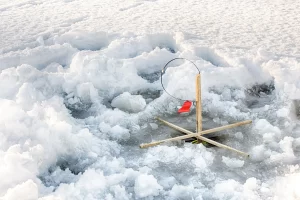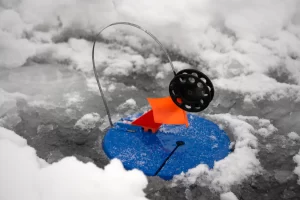Tip-up ice fishing is a winter tradition for many anglers, combining the thrill of fishing with the serene, icy landscapes of frozen lakes. This technique revolves around the use of tip-ups, devices that suspend a baited hook in the water beneath a hole drilled in the ice. When a fish bites, a flag rises or a signal alerts the angler, letting them know it’s time to reel in the catch. While it may seem intimidating to beginners, tip-up ice fishing can be a simple and rewarding activity with the right preparation and equipment.
Safety First: Ensuring Ice Thickness
Before stepping onto the ice, it’s crucial to ensure the ice is thick enough to support weight. For tip-up fishing, ice needs to be at least 4 to 5 inches thick to be considered safe. Many state regulatory agencies will release advisories when the ice is ready for fishing, but anglers can also check the thickness themselves with an ice auger. It’s always wise to carry ice safety spikes or an ice pick in case of an accidental fall through thin ice.
Conditions can vary, even on the same lake, so it’s important to stay alert to the changing nature of the ice. Safe ice is typically clear with a bluish or black tint, while unsafe or “soft” ice appears cloudy, gray, or white. A tool known as a spud bar is commonly used by experienced ice anglers to check ice safety. This long metal rod is used to whack the ice every few steps, ensuring that it remains thick and safe for travel.
For those fishing in extremely cold conditions, where tip-up holes tend to freeze over quickly, thermal tip-ups are a great option. These specially designed devices feature covers that insulate the hole, preventing it from freezing solid, which can help avoid the frustration of constantly clearing the hole of ice.

Essential Gear for Tip-Up Ice Fishing
One of the key factors in successful tip-up ice fishing is having the right gear. A typical tip-up is either made of wood or plastic and is designed to suspend a baited hook beneath the ice. The device uses a spring-loaded trigger mechanism that releases when a fish bites, popping up a flag to alert the angler. Some advanced tip-ups come equipped with bells or even send a text alert to the angler when there’s action.
Because tip-up fishing doesn’t use a traditional rod and reel, once a fish bites, the angler pulls in the line by hand. Choosing the right line is crucial for success. Expert ice anglers often recommend using a braided nylon or Dacron main line for strength, with a fluorocarbon leader attached. The leader’s length and weight should be adjusted depending on the species being targeted. For smaller fish like perch or crappie, a lighter, 6-to-8-pound fluorocarbon leader with a small treble hook works well. Larger species like walleye or pike require a heavier, 10-to-12-pound leader.
In waters where steel leaders are not necessary, anglers often find success with fluorocarbon leaders, which allow for a more natural presentation. For pike fishing specifically, a 30-pound fluorocarbon leader is recommended, although there may be occasional bite-offs from larger fish.
Drilling the Hole: Ice Augers and Sounders
Ice augers are essential for drilling through the thick ice to access the water below. Anglers can choose between manual augers, which are powered by physical effort, and motorized augers, which run on gas or electricity. Manual augers are more cost-effective, but motorized options can drill through ice more quickly and with less effort. Another popular option for more casual anglers is using a cordless drill with an ice auger adapter, offering a middle ground between the manual and motorized versions.
Once the hole is drilled, a sounder is used to measure the water depth. This is important because most tip-up rigs are designed to suspend the bait just above the bottom of the lake, where many fish species tend to linger during the winter months.
Bait Selection for Tip-Up Fishing
When it comes to baiting tip-ups, live bait is often the go-to choice. Live bait creates movement beneath the ice, which attracts fish. Popular live baits for tip-up ice fishing include smelt, suckers, shiners, minnows, and shad, depending on the region. Artificial lures can also be used, but they tend to be less common in tip-up fishing.
Live bait needs to be fresh to remain effective, so it’s recommended to rebait the line every hour or two. This helps ensure that the bait remains active and enticing to fish beneath the ice.

Staying Warm: Apparel and Shelters
Ice fishing can be a brutal experience without the right gear to stay warm. Frigid temperatures, wind, and exposure to the icy lake surface can quickly sap body heat. To combat the cold, it’s essential to wear proper cold-weather apparel, including insulated bibs, jackets, boots with good traction, gloves, hats, and a base layer. Face protection can also make a big difference in comfort on especially cold days.
In addition to clothing, many ice anglers rely on portable ice shelters, also known as shanties, to block the wind and create a warmer environment. These shelters can range from small pop-up tents to larger structures that stay on the ice for the season. Some anglers even add portable heaters inside their shelters for extra warmth.
The Joy of Tip-Up Ice Fishing
Tip-up ice fishing is a unique way to experience the outdoors in winter, providing anglers with an opportunity to enjoy the cold season while still pursuing their passion for fishing. While beginners may be intimidated by the cold and the unfamiliar equipment, with the right preparation, tip-up fishing can be a fun and productive way to spend time on the ice.
With safety as the top priority, proper gear selection, and a solid understanding of the environment, tip-up ice fishing can quickly become an enjoyable winter tradition. For those looking to get started, experimenting with different types of tip-ups and techniques will help refine skills and bring more fish to the ice.
Images/Source: WOS





